February 2024 Newsletter
Table of Contents
|
Welcome!
Thank you so much for subscribing to our e-mail list—and welcome to the first-ever Street Cheese newsletter!
When we started Street Cheese in September 2020, we wanted to create a business that did three things. First, we wanted to make high-quality cheese accessible to more people in different areas of our community—rather than just those living near a high-end grocery store with a specialty cheese counter. Within that goal, we also wanted to support our local cheesemakers in getting their cheeses to market, since we have so many wonderful and hard-working cheesemakers in Washington state.
Second, we wanted to take control of our customers’ cheese experience; for us, that meant ensuring the best possible cheese care, offering a carefully crafted, seasonally appropriate rotating selection, being able to innovate and try new techniques to best serve our cheese selection, and providing cheese education in various forms to help demystify what can be a very intimidating food group.
Third, we wanted to create a space for community centered around good cheese and good food. That has come to mean a variety of things, from roving events, classes, and tastings, to trying to put down roots in the form of a brick-and-mortar store that will hopefully become a hub within the community.
We are looking forward to using this newsletter to keep you updated as Street Cheese drives into the future. We will include cheese-related stories and tips in each newsletter, let you know about some of our upcoming events before they land on our social media calendar, and give you hot tips about cheeses we are bringing in soon.
Be sure to add StreetCheeseSEA@gmail.com to your email contacts. While we love eating spam, we do not love it when our messages land in your spam folder!
Finally, please let us know what you thought of this newsletter, and if there is anything you would like to see in next month’s edition. Thank you for coming along for the ride. We appreciate you.
Yours in Cheese,
Courtney and Tailor
P.S. We are hoping to launch a crowd-funding campaign later this month to help us raise money to open our brick-and-mortar location this autumn. It would mean a lot if you would assist us in spreading the word—and even by donating, if you are able. Stay tuned for that announcement, hopefully in a few weeks.
Cheese News
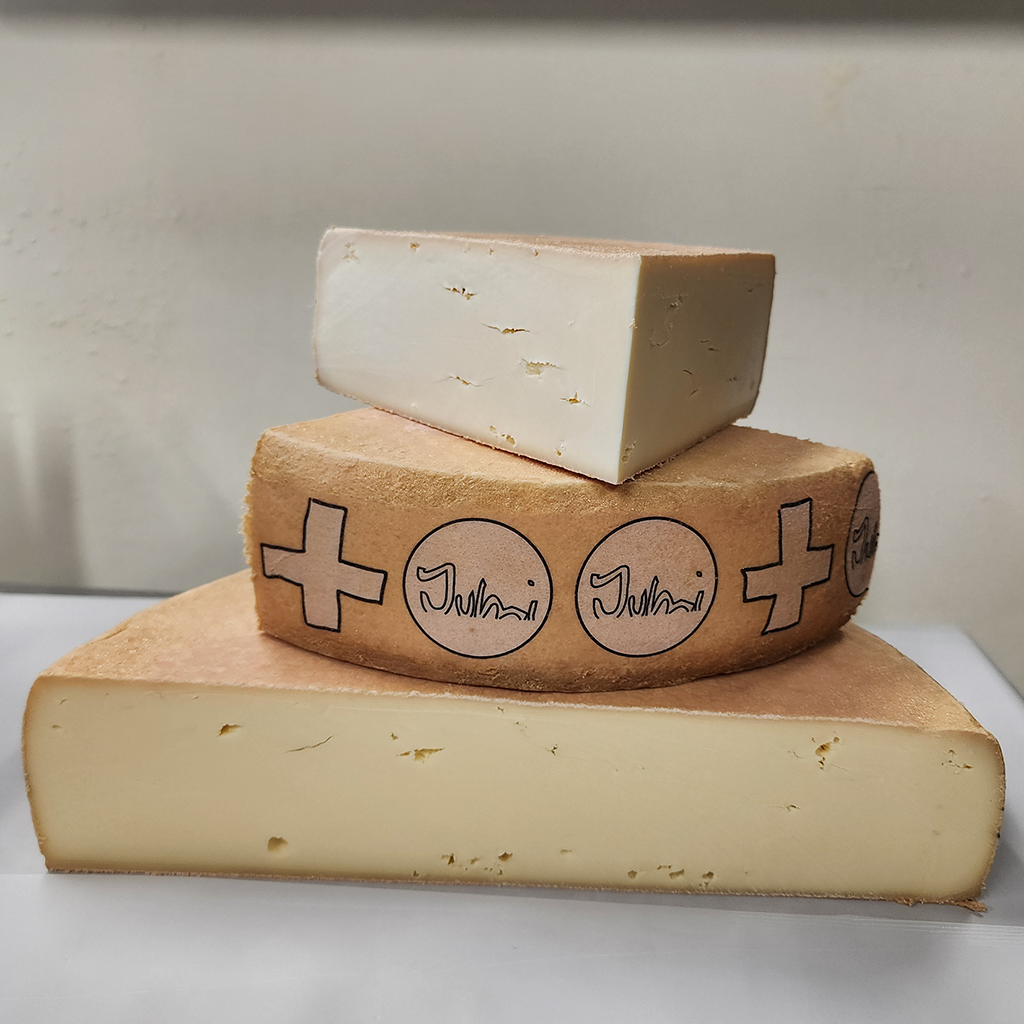
Even though the weather has been unseasonably warm, it’s still winter—which means it is the season for savory washed-rind and Alpine-style cheeses that melt nicely. It’s also still peak comfort food-cooking season, which calls for great finishing cheeses for all those soups, roasted winter veggies, and casseroles. Here are a few of our current highlights:
Almnäs Bruk Tegel: raw cow’s milk Alpine-style (cooked, pressed) cheese from Hjo, Sweden, aged 18 months. The cheese story at the end of this newsletter is about the creamery that makes this rare and delightful cheese!
Don Froylan Cotija and Cotija Enchilado: pasteurized cow’s milk milled-curd cheese from Salem, Oregon. Cotija isn’t just for roasted corn and tacos. This crumbly, salty cheese goes really well with roasted vegetables—especially those in the squash family. You can broil or grill the cheese with slices of vegetables, wrapped in foil, for a fun texture. You can also just crumble it onto whatever you are eating. The Enchilado is classic Cotija, but washed on the outside with Chile de Arbol. It’s great for adding spice and texture to food, but it’s pretty tasty with dark chocolate and citrus marmalade for a fun take on the dessert course.
Giorgio Cravero Parmigiano Reggiano: raw cow’s milk cooked-pressed cheese from Italy, aged 2 years. This isn’t just any old parmesan: Giorgio’s Parmigiano Reggiano is flipped far more frequently than most wheels, leading to a softer, less cakey texture. It’s also made by a creamery that turns out just 10 wheels of cheese per day—one of the smallest makers in the Parmigiano consortium—and is one of only a few dozen of the 300 Parmigiano Reggiano cheesemakers who make cheese from exclusively mountain pastures. This is a cheese you can absolutely eat on its own, perhaps drizzled with some good balsamic vinegar—but it will also add that special finish to whatever you are cooking.
Jumi Aarewasser: raw cow’s milk washed-rind Alpine-style cheese from Switzerland. This silky-smooth double-cream cheese melts like magic and is a great stand-in for Raclette. Need we say more?
Quattro Portoni Casatica di Bufala: pasteurized water buffalo milk soft-ripened bloomy-rind cheese from Lombardy, Italy, aged 40 days. This fudgy, luscious cheese is not quite like a brie, but it could well replace brie on your next cheese board. We think this cheese is best in the winter months when it is at its richest and the water buffalo milk is sweetest. The current batch has an interesting mustard green note to it – perfect for pairing with hearty braising greens.
Lost Peacock Creamery Black Hole Sun: pasteurized goat’s milk gouda-style (washed-curd) cheese from Olympia, Washington, aged two months. This gouda-inspired cheese is great for melting with its smooth, velvety texture—attributes that, along with the cheese’s subtle sweetness, also make it a melt-in-your-mouth yummy snacking cheese. Plus it’s got a cool, grayish-black rind that’s made from applying vegetable ash, rosemary, oregano, and lard to the outside of the cheese. Plus we also have the very last wheel of Jacobs & Britchford Ameribella, a soft-ripened, washed-rind cheese styled after Taleggio that was made in Indiana with raw cow’s milk. It’s a super delicious cheese, mild and buttery but also brothy and savory, and it’s the last chance you’ll ever have to try it.
We also have lots of neat stuff in stock right now; check out our web store to see what’s new
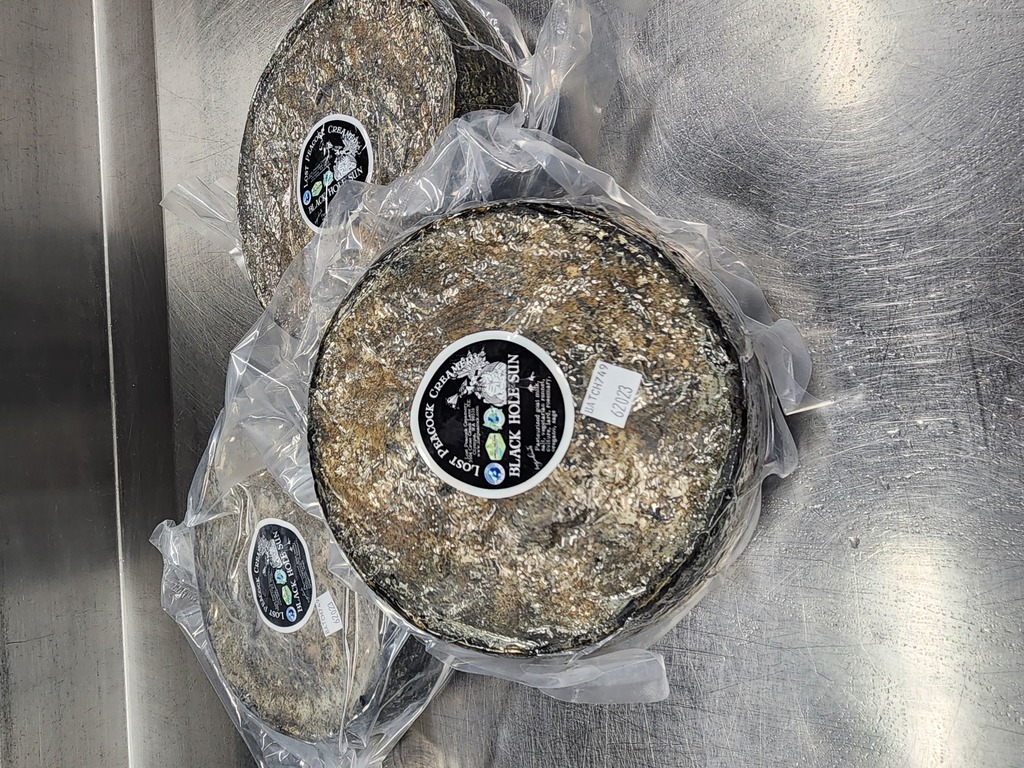
Cheese Club is Here!
You asked, and so we are here to deliver–and to finally announce our Cheese of the Month Club!
We had been wanting to put together a type of Cheese CSA (Community Supported Agriculture), but always struggled with how to execute it. We’ve talked to a few of our loyal customers and finally came to the conclusion that we should stop overthinking how this would work, and to just launch already.
In order to celebrate a different set of cheeses each month, we are offering two options for the Cheese of the Month Club:
“Just the Cheese”: each month, receive 5 different cheeses (over 2 pounds) that have been hand-selected for club members, who get the first crack at them.
“Cheese & Cheese Accessories”: each month, receive 3 different cheeses (roughly 1.5 pounds) plus 3 accompaniments intended to complement the cheeses. These will also be first-chance cheeses that have been thoughtfully paired with new or tried-and-true accompaniments. Cheese of the Month Club drops will be available for local pick-up on a set day each month. If you sign up, you’ll be added to the club list, and then you will receive an email each month letting you know what the pick-up options are so that you can select the one that is most convenient to you. (As always, if you need to find an alternative date or location, please email us to arrange that as early as possible.)
If you sign up for the February Cheese of the Month club—which, by the way, we are announcing first right here, right now!—the official pick-up slot will be at Discover Burien this Saturday, February 10, between 3:00 and 6:00 p.m. (We realize it’s short notice now, so we can work with you if that just isn’t going to happen, but you still want your cheese.) We’ve selected some great cheeses for this one, so we hope you’ll sign on!
We’re hoping to roll out a few more pick-up locations in the future, depending on demand. (The places we currently have in mind are Bickersons Brewhouse in Renton and in Ballard, and possibly also Republic of Cider in SoDo. Feeling strongly about one of those? Let us know!)
In addition to offering two options for the Club, we also have several “subscription” options that you can sign up for: one month, 3 months, 6 months, or 12 months. And yes, you can skip a month if need be; just be sure to send us an email communicating that at least a week in advance.
Upcoming Events
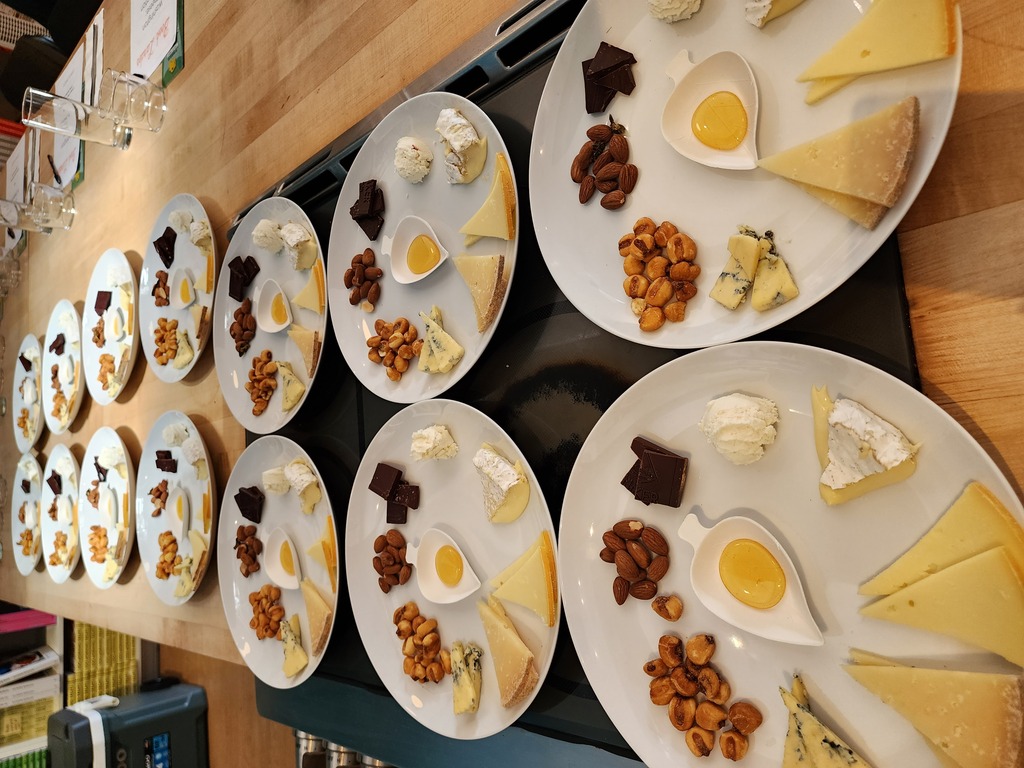
Here are the opportunities to get cheesy with us over the next month, plus a sneak peak at our March offerings: Pop-Up Cheese Shop: Saturday, February 10, from 3:00-6:00 p.m. at Discover Burien in Downtown Burien (611 SW 152nd St). We will be set up to sell cheese by the wedge or wheel, charcuterie by the chub or sliced-to-order, and accompaniments to go with your cheese or meal. If you order the Cheese of the Month Club, you can pick up your first release during this window. Also, if you need a platter or any cheese or charcuterie for the Super Bowl or for Valentine’s Day, this is the time to get it! To place a pre-order, head to our web store.
- Decadent Beer & Cheese Pairing Class: Saturday, February 17, from 7:00-8:30 p.m. at The Beer Junction in West Seattle (4511 California Ave SW). This week is “Chocolate Beer Week” at The Beer Junction, and we’ll be closing it out on a high note with 5 decadent cheese pairings. Tickets to this educational, guided tasting are $45 each and are available through The Beer Junction’s website.
- The Cheese Course: Sunday, February 18, from 10:30 a.m. – 1:00 p.m. at The Pantry in Ballard (1417 NW 70th St). This 2.5-hour class is a deep-dive into sensory evaluation. We’ll taste different milk types and cheese styles, find out how to pair cheese and food based on our own palates, and learn how to talk about what we taste. This class is sold out, but the waiting list does open up sometimes and it doesn’t hurt to get in line if you want to join.
- Wine & Cheese Tasting: Saturday, March 2, at Bacovino in South Seattle (3225 S 116th St, Suite 169). Join us for our first wine and cheese class at Bacovino; we’ll taste vertically through a selection of cheeses and wines while learning how and why they go together. Tickets will be available soon.
- Pop-Up Cheese Shop: Saturday, March 9, at Discover Burien. This will be your next chance to walk up and shop from our full selection from the front window of our commissary kitchen. Whiskey & Cheese Pairing: Thursday, March 14, at Westland Distillery in SoDo (2931 1st Ave S). We are excited to partner with the home of the world’s third best whiskey on this tasting lineup, which will feature whiskey cocktails and straight pours paired to delicious cheeses. Tickets will be available soon.
Cheese Tip of the Month: Portion Sizes
With events like the Super Bowl, Valentine’s Day, and Easter looming on the calendar, entertaining with cheese is a great way to make an impact at a gathering. But how do you know how much to get? There are a couple of rules you can follow, in addition to asking your cheesemonger (*ahem, that’s us!*) for help. Cheese platters and appetizers: in general, you want to get about one ounce of cheese per person. If you are having a cheese plate with a big dinner spread, you can certainly go with a little less—say half an ounce of each cheese per person. If you have a big group of people coming, you can buy slightly less cheese if there will be lots of accompaniments and charcuterie for folks to also munch on. Just make sure there is enough cheese for every person to try them once (so one slice or portion of each cheese per person).
Serving Raclette: if you are melting Raclette cheese to make the traditional Swiss meal, the rule is to have 1 pound of cheese per person. No joke, we swear. We confirmed this during our visit to Switzerland last September, when we ate a Raclette dinner with the folks from Jumi Cheese who make our Swiss Raclette. They also swore it should be 1 pound per person (and they said if you can’t eat that much cheese, you are probably eating too much bread or too many potatoes! They also said to serve Raclette with hot tea rather than with chilled white wine, for better digestibility). If you are having Raclette with lots of sides, you can probably edit down to about half a pound per person.
Cheese in Cooking: follow the recipe! If the recipe calls for a cheese you really like, you can buy a little more and snack on it while you cook. (Need a substitution for a cheese you can’t find or don’t care for? Ask your trusty cheesemonger.) When in doubt, it’s always better to err on the side of caution and order a little more than you think you’ll need for your guests so that you have just enough to not run out. You can always eat the leftovers, or be nice and send them home with someone.
February’s Cheesy Story: A Swedish Cheese Journey
Last August, Courtney had the opportunity to travel to Hjo, Sweden, to visit Almnäs Bruk. We have sold two of Almnäs Bruk’s cheeses in the past: Almnäs Tegel and Wrångeback. Perhaps you’ve tried one or both—maybe at the Vasa Park Resort’s Midsommar Marknåd in 2022, at one of our classes at Skål Beer Hall, or during one of our pop-up shops at Discover Burien?
Almnäs Bruk is an old manor that was founded on the side of Sweden’s second-largest lake, Lake Vättern, by monks in the 1200s—and their takeover of the land was documented in the oldest written text in the Swedish language. The manor passed from the monks to the Swedish king, to the nobility, and over time housed a clay brick factory, a distillery, a cheese plant, and a dairy farm. At the beginning of the last century, it ended up in the hands of the Swedish family that has now runs it for three (and hopefully four!) generations.

When the current manor house was built, clay bricks from the brick factory were used to line the attic to prevent fires from spreading from the roof to the rest of the building—a real danger back in the 1700s, and also today in fire-prone and heavily forested residential swaths of Washington. (Go figure.) Those attic bricks have children’s footprints on them. When the clay bricks were being made, they were sun-dried and the workers’ children must have run across them, leaving behind traces of their romping. The inhabitants of Almnås Bruk were charmed by this and created little footprint stamps to stamp all of the clay bricks that came out of the factory going forward. (There are even old buildings on the property that have footprints imprinted in the brick from the noble families who lived there during the time those buildings were made—like those concrete stepstones you can make today with your children’s or pet’s feet prints, but much more permanent.)
Fast forward to the early 2000s, when current owner Thomas Berglund was resurrecting the cheesemaking facility on Almnäs Bruk that had stopped making cheese in the 1970s, after brickmaking stopped in the early 1960s. The creamery’s original cheese, Wrångeback, is the oldest trademarked good in Sweden and became in 2022 the first Northern European cheese to gain name protected status under the European Union’s PDO—protected designation of origin—system. To re-open the creamery and start making this important cheese again, Thomas had to find the last cheesemaker—who was thankfully still alive—and get him to help recreate the recipe so it could be used again.
But Thomas also wanted to create a new cheese for the creamery to make. Having grown up in the manor house with the foot-printed bricks in the attic and playing along the shores of the lake that are covered in brick beaches created by the workers dumping ugly bricks into the lake 100 years ago, he wanted to show the heritage of the farm in the new cheese. With that in mind, he also wanted to create a cheese that represented his mother, who had come to Almnäs Bruk from Switzerland. Thomas’ favorite cheese is Beaufort, a hearty Alpine-style cheese made in France that is similar to Swiss Gruyère.
So Thomas and his cheese team came up with Almnäs Tegel.

Using raw cow’s milk from the farm’s own herd, they make an Alpine-style cheese and mold it in the shape of a large square brick just like the clay bricks the farm used to produce. Each wheel of cheese is imprinted with the shape of a child’s footprint, hearkening to the farm’s past and the footsteps of all who had walked there before. The baby cheeses are soaked in brine, then washed by hand for several weeks before moving across the property to the cheese cave, where they are cared for and hand brushed more than 100 times over 18 months before being released for sale.
When Courtney was touring the cheese house with Thomas, he showed her the bricks on the wall that also have the stamp of tiny feet prints in them. He told the story of an older worker who had died a few years ago, who had helped to wash the cheeses in that room in the early 2000s. Because of the way that clay bricks trap moisture, beneficial bacteria, and all of the other unseeable elements that create the perfect environment for aging a cheese, Thomas said that even though this worker was dead, part of him lived on in the cheeses aging in that room through the microscopic flora that had come into the room with the worker each time he came to wash cheeses.
This was the terroir of Almnäs Bruk that Thomas was trying to show with his Tegel cheese, the footprints on it and their reference to the past, and the cheese’s role in keeping the farm ecosystem going as a part of the region—because the farm employs lots of workers, is home to many of them, and even runs the local power grid.
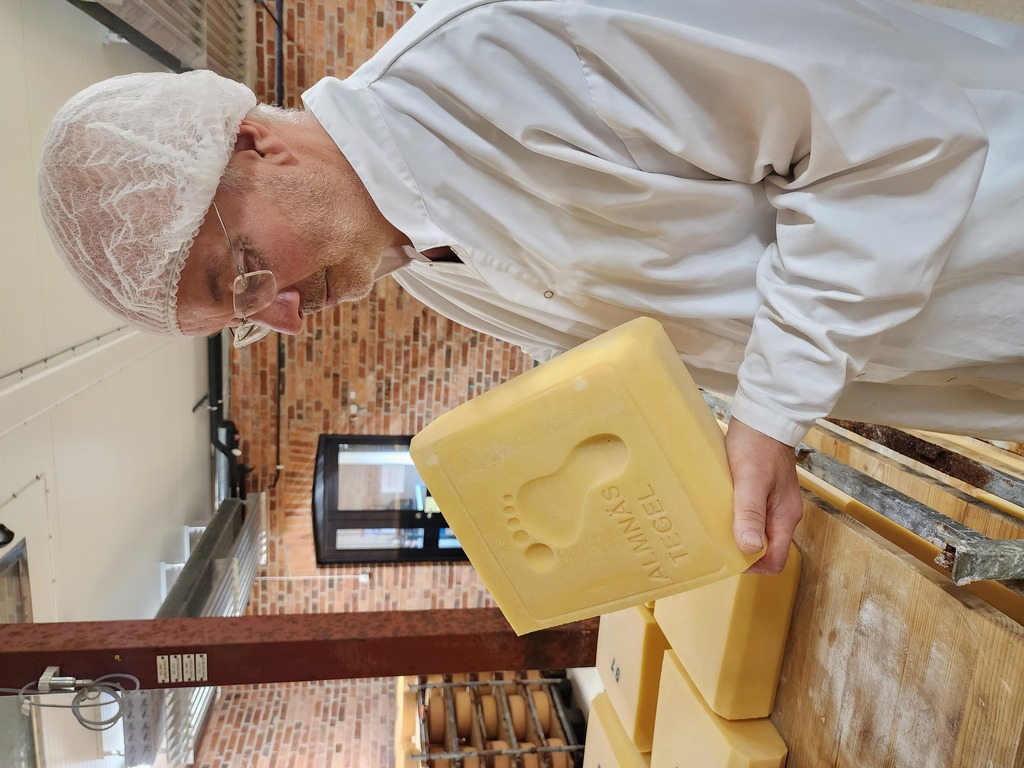
Not only is Tegel a microcosm of the interconnected system of heritage and cheesemaking in Hjo, but it is also delicious. The reason Courtney was there to see the creamery—and to help make a batch of Tegel that we hope to be able to sell in 11 months—was because she chose to present Tegel to the judges at the Mondial du Fromage competition for the best cheesemonger in the world in September as a perfect specimen of a cheese.
When you look at a wheel of Almnäs Tegel, you see that the interior paste is a golden color. Its aroma at the dark brown, crusty rind is particularly savory. It reminds us of brioche bread, mushroom caps, warm spices like nutmeg, and a hint of some cooked milk notes reminiscent of a grilled cheese sandwich. Yet as savory as the aroma of this cheese is, it is also sweet. Sometimes it has notes of cherries, and other times of peach skin—like peaches that are just underripe with soft, fuzzy skin.
Between this sweetness and the warm aromas, you bite into this cheese and through its compact texture you discover a flavor that is both warm and quiet. This cheese isn’t quiet because it has nothing to say, rather it has a lot to say: gently and over time. Slowly the cheese reveals flavors of peanut skin, meat broth, a hint of ocean salinity, possibly a bit of buttery chicken skin.
This cheese is special not just because of its elegant flavor, but also because it is a full-fat cooked, pressed cheese that has not been skimmed—making it a particular challenge to age for 18 months. Thanks to the skill of the cheesemakers and affineurs at Almnäs Bruk, this cheese is very well tempered for a full-fat cheese of its age.
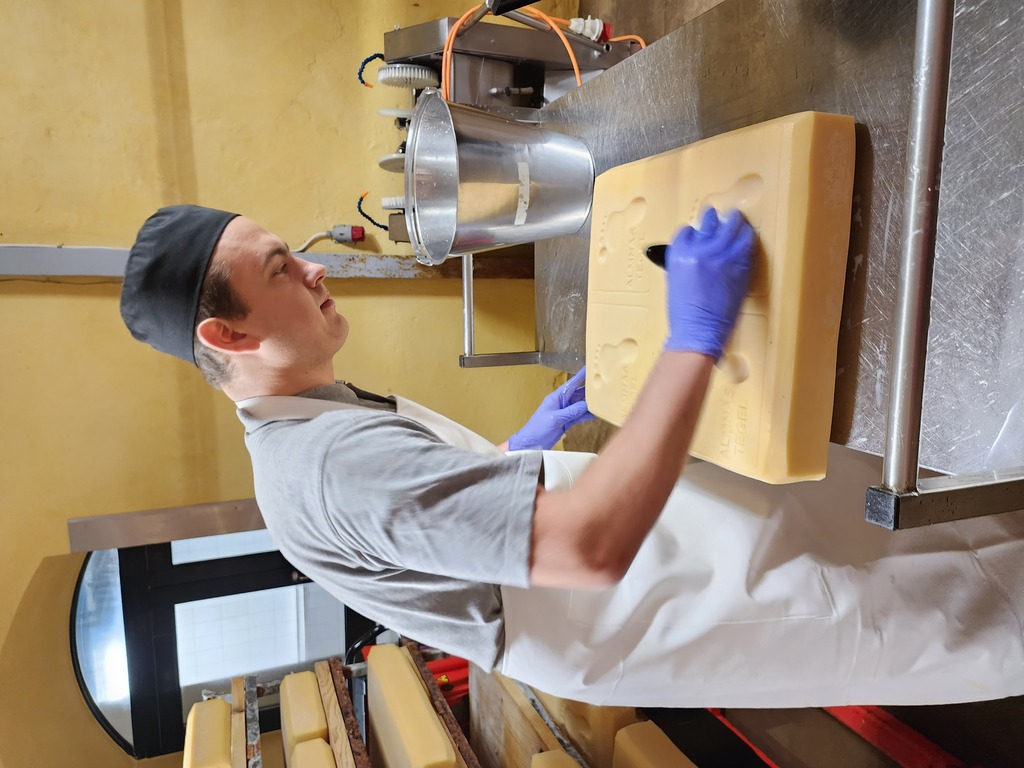
Thomas Berglund likes to enjoy Tegel by itself, quietly over a good book. While we agree that this cheese is very good by itself, we find it also delightful paired with a fruity South American dark chocolate, because the warm notes on the rind and the fruity notes in the dark chocolate meld together to create the illusion of the perfect bar of milk chocolate.
It is also very nice with roasted fruit or a fruit compote, the combination of which helps accentuate the more roasty, meaty notes in the cheese. And if you get thirsty, this cheese is a good match for a malty dark lager, which will bring out more of the yeasty brioche notes at the rind. It could also go well with a savory Chardonnay or a well-balanced Lambrusco, depending on the mood and the weather.
Because this is such a quiet cheese, it is so nice to bring it together with other foods and drinks. Try it with a dry French cider, a cooked farro dish, or even a Gen-Mai Cha tea, a Japanese green tea prepared with puffed rice, which would particularly bring out the cheese’s toasty, roasty, and grassy notes.
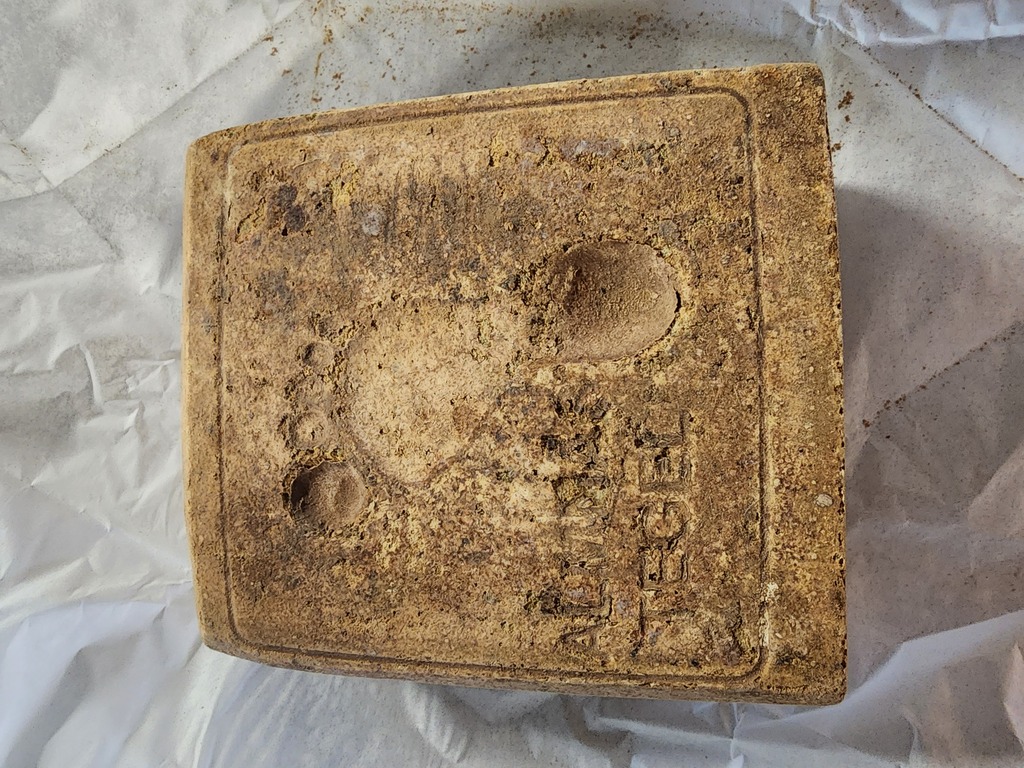
as we envision Street Cheese being an integral part of its community, we love how Almnäs Tegel is a product of community. It supports a manor that was built in 1225, allowing the buildings there to continue to have a use and many people to have a livelihood from the pastures to the cow barn, to the creamery, to the cellars. The creamery, and this cheese, keeps history alive and the memory of ancestors who walked before us—some of them across wet bricks.
And it keeps evolving with the present, both in the sense of flavor, as you can continue to taste notes the longer you hold this cheese in your mouth and enjoy it—and in the ways the folks at the farm work together to produce this food.
Until next time,
—
Courtney Johnson & Tailor Kowis
Co-Owners, Street Cheese LLC




